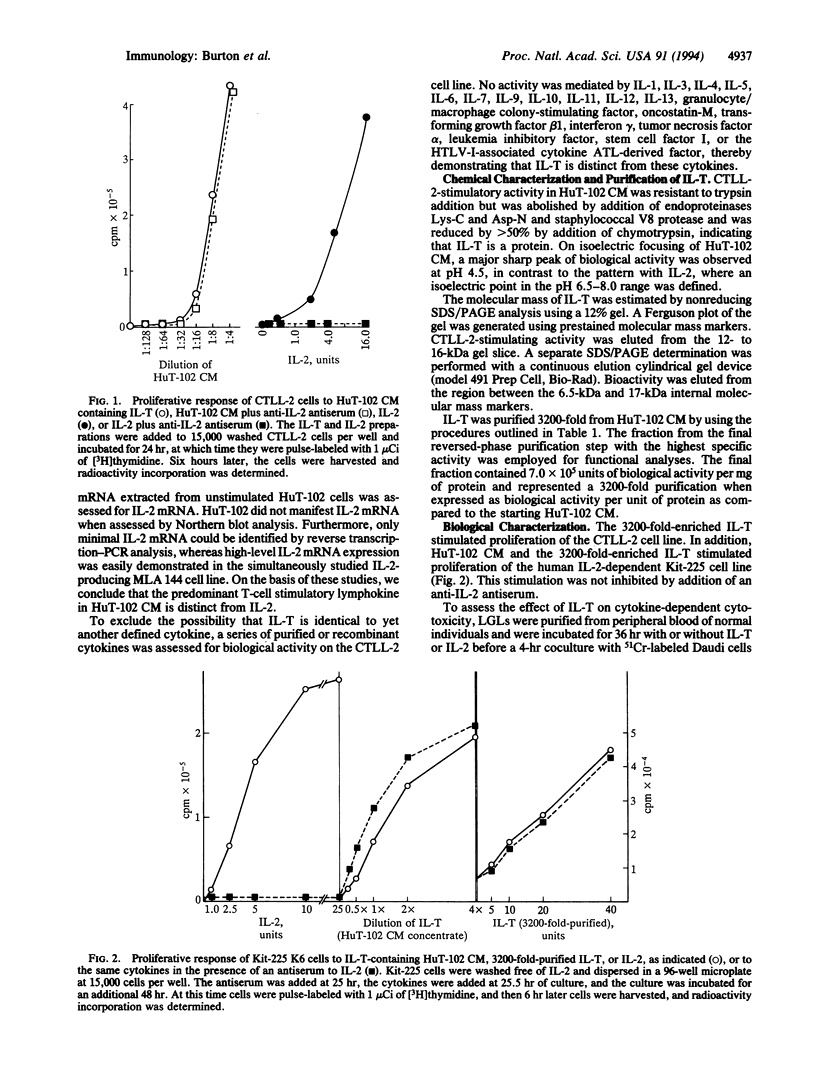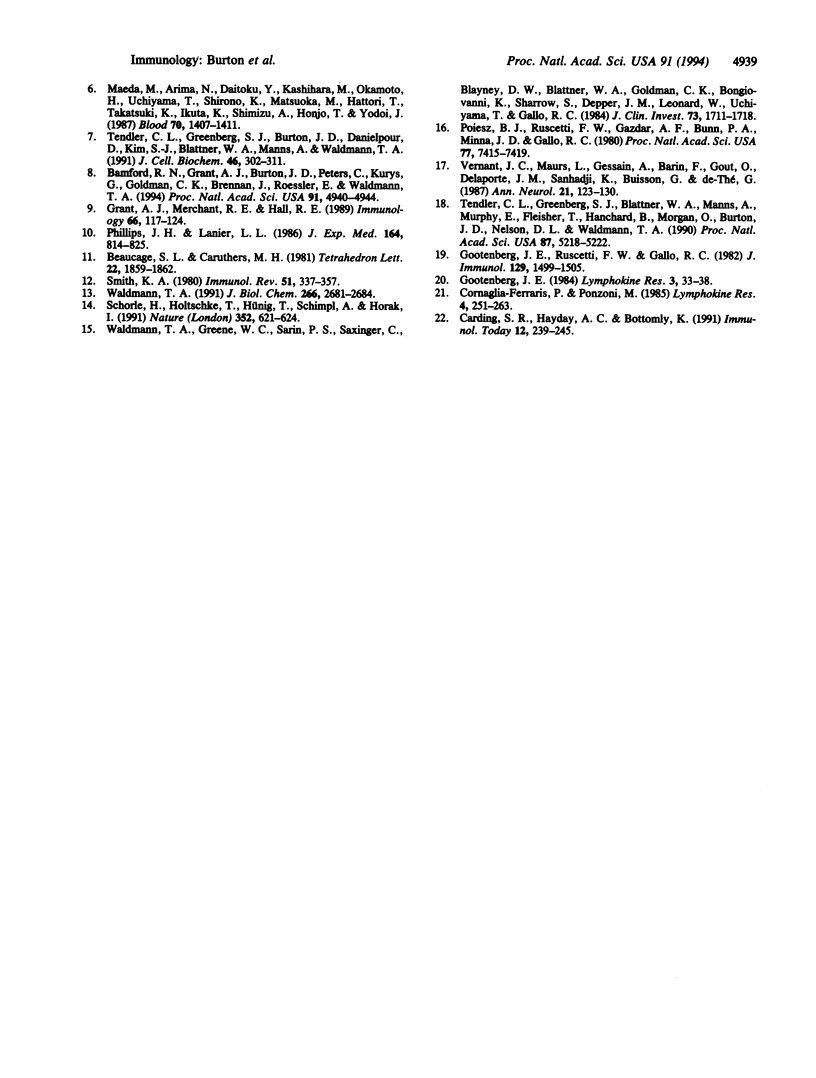Abstract
In early phases of human T-cell lymphotrophic virus I-induced adult T-cell leukemia (ATL), the malignant cell proliferation is associated with an autocrine process involving coordinate expression of interleukin (IL) 2 and its receptor. However, during late-phase ATL, leukemic cells no longer produce IL-2 yet continue to express high-affinity IL-2 receptors. During studies to define pathogenic mechanisms that underlie this IL-2-independent proliferation, we demonstrated that the ATL cell line HuT-102 secretes a lymphokine, provisionally designated IL-T, that stimulates T-cell proliferation and the induction of lymphokine-activated killer cells. Conditioned medium from HuT-102, when added to the IL-2-dependent CTLL-2 line, yielded a stimulation index of 230. Since CTLL-2 was purported to be IL-2-specific, we performed a number of studies to exclude IL-2 production by HuT-102. Stimulation of CTLL-2 cells by HuT-102-conditioned medium was not meaningfully inhibited by addition of an antiserum to IL-2. Furthermore, uninduced HuT-102 cells did not express mRNA encoding IL-2 as assessed by Northern blot analysis. No biological activity on CTLL-2 cells was mediated by purified IL-1, IL-3, IL-4, IL-5, IL-6, IL-7, IL-9, IL-10, IL-12, IL-13, or granulocyte/macrophage colony-stimulating factor, thus differentiating these factors from IL-T. Based on preliminary biochemical data, IL-T is a protein with a pI value of 4.5 and a molecular mass in SDS gels of 14 kDa. In addition to its action on CTLL-2 cells, 3200-fold-purified IL-T stimulated proliferation of the human cytokine-dependent T-cell line Kit-225. Furthermore, addition of IL-T enhanced cytotoxic activity of large granular lymphocytes (i.e., induced lymphokine-activated killer cells). Thus, IL-T is a lymphokine that plays a role in T-cell proliferation and induction of lymphokine-activated killer cells. Furthermore, IL-T may contribute to IL-2-independent proliferation of select ATL cells and lines.
Full text
PDF




Selected References
These references are in PubMed. This may not be the complete list of references from this article.
- Bamford R. N., Grant A. J., Burton J. D., Peters C., Kurys G., Goldman C. K., Brennan J., Roessler E., Waldmann T. A. The interleukin (IL) 2 receptor beta chain is shared by IL-2 and a cytokine, provisionally designated IL-T, that stimulates T-cell proliferation and the induction of lymphokine-activated killer cells. Proc Natl Acad Sci U S A. 1994 May 24;91(11):4940–4944. doi: 10.1073/pnas.91.11.4940. [DOI] [PMC free article] [PubMed] [Google Scholar]
- Carding S. R., Hayday A. C., Bottomly K. Cytokines in T-cell development. Immunol Today. 1991 Jul;12(7):239–245. doi: 10.1016/0167-5699(91)90037-T. [DOI] [PubMed] [Google Scholar]
- Cornaglia-Ferraris P., Ponzoni M. T cells from lymphoepithelial thymoma produce a biochemical variant of IL-2. Lymphokine Res. 1985 Summer;4(3):251–263. [PubMed] [Google Scholar]
- Gearing D. P., Comeau M. R., Friend D. J., Gimpel S. D., Thut C. J., McGourty J., Brasher K. K., King J. A., Gillis S., Mosley B. The IL-6 signal transducer, gp130: an oncostatin M receptor and affinity converter for the LIF receptor. Science. 1992 Mar 13;255(5050):1434–1437. doi: 10.1126/science.1542794. [DOI] [PubMed] [Google Scholar]
- Gootenberg J. E. Biochemical variants of human T-cell growth factor produced by malignant cell lines. Lymphokine Res. 1984;3(2):33–38. [PubMed] [Google Scholar]
- Gootenberg J. E., Ruscetti F. W., Gallo R. C. A biochemical variant of human T cell growth factor produced by a cutaneous T cell lymphoma cell line. J Immunol. 1982 Oct;129(4):1499–1505. [PubMed] [Google Scholar]
- Grant A. J., Merchant R. E., Hall R. E. Interleukin-2 modulates the expression of lymphocyte function-associated antigen-one (LFA-1) and p150,95 during the generation of lymphokine-activated killer (LAK) cells. Immunology. 1989 Jan;66(1):117–124. [PMC free article] [PubMed] [Google Scholar]
- Kishimoto T., Taga T., Akira S. Cytokine signal transduction. Cell. 1994 Jan 28;76(2):253–262. doi: 10.1016/0092-8674(94)90333-6. [DOI] [PubMed] [Google Scholar]
- Kondo M., Takeshita T., Ishii N., Nakamura M., Watanabe S., Arai K., Sugamura K. Sharing of the interleukin-2 (IL-2) receptor gamma chain between receptors for IL-2 and IL-4. Science. 1993 Dec 17;262(5141):1874–1877. doi: 10.1126/science.8266076. [DOI] [PubMed] [Google Scholar]
- Maeda M., Arima N., Daitoku Y., Kashihara M., Okamoto H., Uchiyama T., Shirono K., Matsuoka M., Hattori T., Takatsuki K. Evidence for the interleukin-2 dependent expansion of leukemic cells in adult T cell leukemia. Blood. 1987 Nov;70(5):1407–1411. [PubMed] [Google Scholar]
- Noguchi M., Nakamura Y., Russell S. M., Ziegler S. F., Tsang M., Cao X., Leonard W. J. Interleukin-2 receptor gamma chain: a functional component of the interleukin-7 receptor. Science. 1993 Dec 17;262(5141):1877–1880. doi: 10.1126/science.8266077. [DOI] [PubMed] [Google Scholar]
- Phillips J. H., Lanier L. L. Dissection of the lymphokine-activated killer phenomenon. Relative contribution of peripheral blood natural killer cells and T lymphocytes to cytolysis. J Exp Med. 1986 Sep 1;164(3):814–825. doi: 10.1084/jem.164.3.814. [DOI] [PMC free article] [PubMed] [Google Scholar]
- Poiesz B. J., Ruscetti F. W., Gazdar A. F., Bunn P. A., Minna J. D., Gallo R. C. Detection and isolation of type C retrovirus particles from fresh and cultured lymphocytes of a patient with cutaneous T-cell lymphoma. Proc Natl Acad Sci U S A. 1980 Dec;77(12):7415–7419. doi: 10.1073/pnas.77.12.7415. [DOI] [PMC free article] [PubMed] [Google Scholar]
- Russell S. M., Keegan A. D., Harada N., Nakamura Y., Noguchi M., Leland P., Friedmann M. C., Miyajima A., Puri R. K., Paul W. E. Interleukin-2 receptor gamma chain: a functional component of the interleukin-4 receptor. Science. 1993 Dec 17;262(5141):1880–1883. doi: 10.1126/science.8266078. [DOI] [PubMed] [Google Scholar]
- Schorle H., Holtschke T., Hünig T., Schimpl A., Horak I. Development and function of T cells in mice rendered interleukin-2 deficient by gene targeting. Nature. 1991 Aug 15;352(6336):621–624. doi: 10.1038/352621a0. [DOI] [PubMed] [Google Scholar]
- Smith K. A. T-cell growth factor. Immunol Rev. 1980;51:337–357. doi: 10.1111/j.1600-065x.1980.tb00327.x. [DOI] [PubMed] [Google Scholar]
- Tendler C. L., Greenberg S. J., Blattner W. A., Manns A., Murphy E., Fleisher T., Hanchard B., Morgan O., Burton J. D., Nelson D. L. Transactivation of interleukin 2 and its receptor induces immune activation in human T-cell lymphotropic virus type I-associated myelopathy: pathogenic implications and a rationale for immunotherapy. Proc Natl Acad Sci U S A. 1990 Jul;87(13):5218–5222. doi: 10.1073/pnas.87.13.5218. [DOI] [PMC free article] [PubMed] [Google Scholar]
- Tendler C. L., Greenberg S. J., Burton J. D., Danielpour D., Kim S. J., Blattner W. A., Manns A., Waldmann T. A. Cytokine induction in HTLV-I associated myelopathy and adult T-cell leukemia: alternate molecular mechanisms underlying retroviral pathogenesis. J Cell Biochem. 1991 Aug;46(4):302–311. doi: 10.1002/jcb.240460405. [DOI] [PubMed] [Google Scholar]
- Vernant J. C., Maurs L., Gessain A., Barin F., Gout O., Delaporte J. M., Sanhadji K., Buisson G., de-Thé G. Endemic tropical spastic paraparesis associated with human T-lymphotropic virus type I: a clinical and seroepidemiological study of 25 cases. Ann Neurol. 1987 Feb;21(2):123–130. doi: 10.1002/ana.410210204. [DOI] [PubMed] [Google Scholar]
- Waldmann T. A., Greene W. C., Sarin P. S., Saxinger C., Blayney D. W., Blattner W. A., Goldman C. K., Bongiovanni K., Sharrow S., Depper J. M. Functional and phenotypic comparison of human T cell leukemia/lymphoma virus positive adult T cell leukemia with human T cell leukemia/lymphoma virus negative Sézary leukemia, and their distinction using anti-Tac. Monoclonal antibody identifying the human receptor for T cell growth factor. J Clin Invest. 1984 Jun;73(6):1711–1718. doi: 10.1172/JCI111379. [DOI] [PMC free article] [PubMed] [Google Scholar]
- Waldmann T. A. The interleukin-2 receptor. J Biol Chem. 1991 Feb 15;266(5):2681–2684. [PubMed] [Google Scholar]


